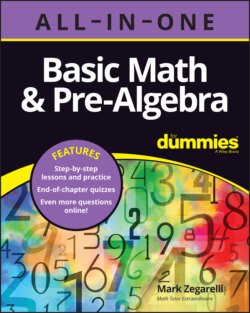Читать книгу Basic Math & Pre-Algebra All-in-One For Dummies (+ Chapter Quizzes Online) - Mark Zegarelli - Страница 76
Understanding exponents
ОглавлениеExponents (also called powers) are shorthand for repeated multiplication. For example, means to multiply 2 by itself three times. To do that, use the following notation:
In this example, 2 is the base number and 3 is the exponent. You can read as “2 to the third power” or “2 to the power of 3” (or even “2 cubed,” which has to do with the formula for finding the volume of a cube — see Chapter 19 for details).
Here’s another example:
That works out like this:
This time, 10 is the base number and 5 is the exponent. Read as “10 to the fifth power” or “10 to the power of 5.”
When the base number is 10, figuring out any exponent is easy. Just write down a 1 and that many 0s after it:
| 1 with two 0s | 1 with seven 0s | 1 with twenty 0s |
|---|---|---|
Exponents with a base number of 10 are important in scientific notation, which I cover in Chapter 17.
The most common exponent is the number 2. When you take any whole number to the power of 2, the result is a square number. (For more information on square numbers, see Chapter 1.) For this reason, taking a number to the power of 2 is called squaring that number. You can read as “three squared,” as “four squared,” and so forth. Here are some squared numbers:
Any number (except 0) raised to the 0 power equals 1. So are equivalent, or equal, because they all equal 1.
